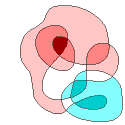Among the above formulae, the least popular is surely the
one involving an irreducible nabla
(as tabulated above in terms of cartesian coordinates).
I believe it has never been given a special name:
òòS
[ div U dS -
(U.Ñ) dS ]
=
òC
U ´ dr
The next section features this formula and demonstrates
what's involved in elementary proofs of such, when more elegant general reasoning is shunned.
Highbrow
Poincaré duality
is a loosely related topic.
 This apparent area is a signed quantity which
is positive for an observer
looking at the north side of the loop
(readily identified if the loop is not too twisted).
This apparent area is a signed quantity which
is positive for an observer
looking at the north side of the loop
(readily identified if the loop is not too twisted).
The area vector, or surface vector is an
axial vector,
defined by a contour integral around the oriented loop:
S
= ½
òC+
r ´ dr
For a closed loop C+ this defining integral does not depend on the
choice of origin for the position vector r.
Anyone encountering this for the first time is encouraged to
work out S explicitely for
a circle of radius R, with the following parametric equations
(0 < q < 2p).
x = a + R cos q
;
y = b + R sin q
;
z = c
For simple planar loops, the magnitude of S
is simply the usual
surface area enclosed by the loop
(the vector is perpendicular to the plane and points to whichever direction is implied
by the orientation of the loop).
This definition is consistent with the general integration formulas
tabulated above.
(HINT: With U = r
you'll end subtracting two very simple integrands:
3 dS and dS.)
An Elementary Argument :
The apparent area surrounded by a simple planar curve is proportional to the cosine of its
tilt to the observer.
This establishes the advertised property in terms of scalar products,
for all simple oriented planar curves, including triangles.
The same is true of a non-planar quadrilateral, because such a polygon
always has the same apparent area as two triangles sharing an
edge (one of the quadrilateral's diagonal) if they are oriented
in such a way that this hinge is traveled in opposite directions.
The quadrilateral contour is effectively equivalent to that of the triangles
(as the hinge would be counted once positively and once negatively if the triangles
were considered individually).
This argument may be extended by induction to any polygon and, by continuity,
to any smooth enough curve.
So, the above formula for S
and its relevance to apparent areas hold for all rectifiable
3D curves. 
An elementary proof of the Kelvin-Stokes formula
could proceed similarly.
Note that the surface area of a surface bounded by a given loop
has little to do with the above vectorial area. For example,
an hemisphere of radius R has a surface area of
2pR2,
which is twice the magnitude of the equator's vectorial area...
The vectorial area of an entire sphere is zero !